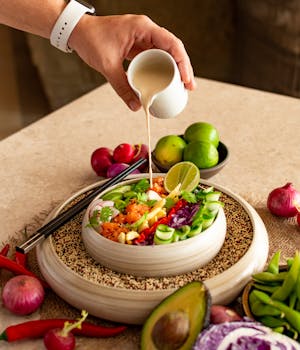Benefits
Flavor Enhancement
Nutritional Value
Heart Health
Digestive Health
Dietary Versatility
Get creative with Dressing
Marinade for meat or vegetables brings out a depth of flavor when grilling or roasting
A savory base for a pasta salad, giving it a tangy twist
As a finishing touch on roasted vegetables, adding a zest that enhances their natural sweetness
Mixed into mashed potatoes or a casserole for an unexpected burst of flavor
Used as a dipping sauce for appetizers or snacks, like chicken wings or vegetable sticks, dressing can add a deliciously tangy or creamy dimension
Something you can make with Dressing
Origin
The term \"dressing\" in the culinary context refers to a sauce or mixture used to flavor and enhance salads, sandwiches, and other dishes. The concept of dressing can be traced back to ancient times.\n\nIn ancient Rome, a dressing called \"garum\" was commonly used. Garum was a fermented fish sauce that was highly prized for its savory flavor. It was made by fermenting fish, typically anchovies, with salt and allowing it to mature over several months. Garum was widely used as a condiment and flavor enhancer in Roman cuisine.\n\nOver time, dressings evolved and diversified in different regions around the world. In European cuisine, the tradition of using oil and vinegar-based dressings began to emerge. The French popularized vinaigrettes, which are made by combining vinegar, oil, and various herbs and seasonings.\n\nIn the United States, dressings like ranch, blue cheese, and thousand island became popular in the mid-20th century. These creamy dress
